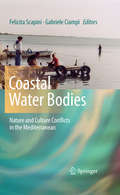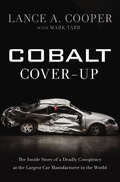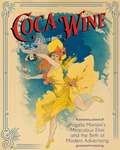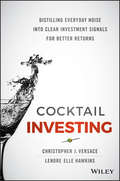- Table View
- List View
Coastal Water Bodies: Nature and Culture Conflicts in the Mediterranean
by Felicita Scapini Gabriele CiampiAddressing the links between science and the real world with a sound scientific baseline, Coastal Water Bodies targets researchers of various disciplines whose interest lies in the integrated sustainable management of coastal water bodies. The main topic of this book is not the ecology according to its accepted meaning, but rather the 'places and people' concerned - the coastal zones of the Mediterranean that are rich in ecological value and the local people who survive thanks to these environmental resources. Integration is the joint consideration of different aspects of water uses and values, and new ways of understanding and managing conflicts around water use are needed if people are to benefit from integration. Sustainability of the ecological and socioeconomic environments requires a climate in which conflicts, if they need to exist, are properly managed in a non-destructive manner.
Coats: Supply Chain Challenges
by Willy Shih Adina WongCoats, the largest thread maker in the world, transformed its business to digital colour measurement so that it could respond better to customer demand in the garment industry for rapid product cycles and more fragmented colour choices. Its embrace of digital colour measurement technologies enabled customers to drive ever shorter fulfilment cycles. But the company faced a monumental challenge in forecasting demand for the wide spectrum of colours and thread types, and it had shifted to an ABC inventory classification model for make-to-stock versus make-to-order products. The question at hand was whether it should now consolidate some of its high volume make-to-stock manufacturing in an ultra-low-cost location while leaving the make-to-order products close to the customer.
Coauthoring the Myth: Building an Iconic Brand with the Help of the Culture Industries and Populist Worlds
by Douglas B. HoltThe Harley-Davidson Company is everyone's favorite company turnaround story. But conventional explanations about Harley's path to success fail to acknowledge that the so-called Harley mystique is nothing other than the brand's identity myth, bolstered by the storytelling of two powerful coauthors: the populist world of outlaw bikers and the culture industries. What are the lessons to be drawn from Harley's brand myth?
Cobalt Cover-Up: The Inside Story of a Deadly Conspiracy at the Largest Car Manufacturer in the World
by Mark Tabb Lance A. CooperFollowing a deadly car crash, small-town lawyer Lance Cooper risked everything to battle one of the most powerful auto corporations in the world to get justice for a young woman. A fast-paced, journalistic account of tragedy turned to triumph, despair to hope, Cobalt Cover-Up is an inspirational, thoroughly compelling, and victorious read. In the midst of his own family struggles, small-town Georgia lawyer Lance Cooper agreed to defend Ken and Beth Melton and investigate the deadly accident that killed their daughter Brooke after she inexplicably lost control of her Chevy Cobalt. But what started as a heartbreaking yet all too common lawsuit quickly escalated into a David vs. Goliath case when Cooper discovered shocking evidence that General Motors concealed an ignition switch defect for nearly a decade--resulting in 124 deaths, including Brooke's, and risking the lives of millions more. Despite GM's settlement offers and attempts to bury evidence, Cooper refused to back down and worked tirelessly to expose the truth. Locked in a tenacious legal fight, Cooper and the Meltons faced incredible odds--Ken and Beth losing jobs and suffering the difficulty of grieving a beloved daughter during a court battle, Cooper risking his reputation and private practice against the overwhelming opposition from GM's team of lawyers, and both parties facing massive financial strain. Yet, in the relentless pursuit for justice and to protect future innocent lives, this small-town lawyer and a working-class American couple stared down the biggest US auto manufacturing mogul and ultimately transformed the entire industry.
Coca Wine: Angelo Mariani’s Miraculous Elixir and the Birth of Modern Advertising
by Aymon De LestrangeA lavishly illustrated history of coca wine and the revolutionary advertising methods that made it a world-wide success • Follows 19th-century pharmacist Angelo Mariani’s interest in coca from medical uses to the development and healing effects of his world-famous coca wine, Vin Mariani • Explores the botany of coca, how it differs from cocaine, its traditional uses, and early scientific studies on coca from doctors, including Sigmund Freud • Examines Mariani’s highly successful international advertising campaigns, the first to use celebrity endorsements, including testimonies from Pope Benedict XV, Sarah Bernhardt, Thomas Edison, Jules Verne, H. G. Wells, William McKinley, Emile Zola, and Alphonse Mucha One of the oldest and most potent natural stimulants, the leaves of the coca plant are the organic source from which cocaine is synthesized. Fresh coca leaves and products made from them have verified medicinal and healing properties--and not the same addictive qualities or negative side effects as cocaine. In the late 19th century coca products became hugely successful in Europe and the United States. The most famous was Vin Mariani, a coca-based tonic wine developed by Corsican pharmacist Angelo Mariani (1838-1914). Many celebrities sang its praises, including Pope Benedict XV, Sarah Bernhardt, Thomas Edison, H. G. Wells, William McKinley, Emile Zola, and the doctors of Ulysses S. Grant, who credited Vin Mariani with giving him the strength to finish his memoirs before his death. In this full-color illustrated history of coca wine, the first of its kind, author Aymon de Lestrange follows Mariani’s interest in coca from its medicinal applications to the creation of the tonic wine. The author explores the botany of coca, how it differs from cocaine, its traditional use in pre-Columbian America, and scientific studies on coca from the 17th through 19th centuries, including from Sigmund Freud, who was a known user. He describes the introduction of coca in the U.S. and France and the many coca preparations then available at drugstores. He also studies the introduction of cocaine in these two countries and the prohibition laws that followed. Aymon de Lestrange demonstrates how Mariani became, in many ways, the father of modern advertising with his highly successful advertising campaigns. He includes vivid reproductions of Mariani’s advertisements, many not seen since their original publication in the late 19th and early 20th centuries, and shows how Mariani commissioned the top writers and artists of the day, such as Jules Chéret and Alphonse Mucha, to produce works celebrating coca wine. The author reveals how Vin Mariani was the forerunner of Coca-Cola, which clearly plagiarized not only Mariani’s product but also his advertising methods. Looking to the future of coca, the author shows how it has gained renewed interest in the scientific community for its therapeutic and nutritional properties and in the spiritual community, which is seeking to rehabilitate the reputation of coca, the sacred plant of the Incas.
Coca-Cola Co. (A)
by David F. HawkinsIn order to fully appreciate Coca-Cola's profitability, financial risk, and operating risk, Jane Wilson, a security analyst, is considering preparing a consolidated financial statement for Coca-Cola analyzing Coca-Cola Enterprises as a fully consolidated entity.
Coca-Cola Co. (A): The Rise and Fall of M. Douglas Ivester
by Cate Reavis Michael D. Watkins Carin-Isabel KnoopChronicles M. Douglas Ivester's 26-month term as chairman and CEO of The Coca-Cola Co., and how he navigated the company through a series of what some considered "small crises."
Coca-Cola Co. (B): Douglas Daft Takes Over
by Cate Reavis Michael D. Watkins Carin-Isabel KnoopDescribes Douglas Daft's first quarter as chairman and CEO of The Coca-Cola Co. Highlights actions taken to resolve issues that arose under M. Douglas Ivester's 26-month term.
Coca-Cola Company (A): The Rise and Fall of M. Douglas Ivester (Abridged)
by Cate Reavis Michael D. Watkins Carin-Isabel KnoopThis is a shortened version of The Coca-Cola Company (A): The Rise and Fall of M. Douglas Ivester, HBS case #9-800-355. It eliminates some background detail and the financial data and exhibits. As with the original case, it chronicles the appointment of Douglas Ivester as CEO of Coca-Cola and the missteps that led to his dismissal.
Coca-Cola Harmless Warrants
by Mihir A. Desai Scott P. MasonUnderscores the arbitrage implicit in the pricing of a complex unit of debt and warrants issued by the Coca-Cola Co.
Coca-Cola in 2011: In Search of a New Model
by David B. Yoffie Renee KimMuhtar Kent, CEO of the Coca-Cola Company, faced a critical decision in 2011 after closing a $12 billion deal to buy its troubled North America bottling operations from its biggest bottler, Coca-Cola Enterprises. The decision was prompted by several changes in the U.S. market, including the bottler's inability to make crucial investments, the growth of alternative, non-sparkling drinks, and the growing power of national accounts, such as Wal-Mart. Now that Coke owned most of its North American bottling network, Kent had to decide whether keeping the labor and capital-intensive side of the bottling business was in Coke's long-term strategic interest. If not, should he re-franchise the bottling business, again, as Coke had done in the past? Or was there a third path? For one of the most successful companies in the world over the last 100 years, Kent's answers to these questions had the potential to redefine Coke's business model for the next century.
Coca-Cola on Facebook
by John Deighton Leora KornfeldIn late 2008, executives at Coca-Cola had to decide what to do with a fan-created page on Facebook that had amassed over one million followers in three months. From a legal point of view the fan-created page was in violation of Facebook's terms of service, because a non-copyright holder was using the imagery and logo associated with a known brand. Facebook contacted Michael Donnelly, Group Director, Worldwide Interactive Marketing for The Coca-Cola Company, to let him know that he was in the position to take down the hugely popular fan-created site or, conversely, he could take it over and make it an official marketing channel for the company. Coke was already revisiting its social media policies, with the Diet Coke and Mentos user-generated video incident fresh in its memory. Those videos, which featured elaborate geysers with Diet Coke as their main ingredient, were among the most viewed online videos at the time but were not initially sanctioned by the company. Donnelly knew that opening up the brand to creative consumers was necessary, but he and his team had to figure out how and to what extent they should do so while still protecting one of the world's most valuable brands.
Coca-Cola vs. Pepsi-Cola and the Soft Drink Industry
by Michael E. Porter Rebecca WaylandDescribes the competition between Coca-Cola and Pepsi-Cola. Provides a summary of the history of the soft drink industry prior to World War II, and over the period 1950-1990 in greater detail. Major strategic competitive moves and countermoves are described. Also profiles industry developments, including the Pepsi Challenge, the reformulation of Coca-Cola, and the consolidation of the bottler network. Provides a teaching vehicle for analysis of competitors and strategic rivalry. An updated and revised version of an earlier case.
Coca-Cola's New Vending Machine (A): Pricing to Capture Value, or Not?
by Charles King Das NarayandasChairman and CEO M. Douglas Ivester stumbles when he tells a Brazilian newsmagazine about a new Coke vending machine that can automatically raise prices in hot weather. Reaction around the world is swift and negative.
Coca-Cola: Preparing for the Next 100 Years
by James Weber Cynthia A. MontgomeryIn early 2020, James Quincey, the 14th chair of the 133-year old The Coca-Cola Company, was in the midst of a years-long transformation of Coca-Cola from being the leading carbonated soft drink (CSD) beverage company into a total beverage company. The company's flagship product, Coca-Cola, had been the world's best-selling beverage for 100 years, yet some consumers were turning away from CSDs due to health concerns over sugar consumption and a proliferation of other beverage options. The company had both acquired and developed many new beverage brands. It was in the process of changing its culture to be faster moving and more willing to take risks, and a culture where the new brands meant as much to the company as did its flagship product, which was still the company's largest selling beverage. Coca-Cola was also working to improving its environmental sustainability and social consciousness activities, and building a company where people were proud to work. The case also provides a historical look at the company's development, its relations with bottlers, competition with rival PepsiCo, and ends with emerging issues in the early days of the COVID-19 pandemic.
Cochabamba, 1550–1900: Colonialism and Agrarian Transformation in Bolivia
by Brooke LarsonWinner of the 1990 Best Book Award from the New England Council on Latin American StudiesThis study of Bolivia uses Cochabamba as a laboratory to examine the long-term transformation of native Andean society into a vibrant Quechua-Spanish-mestizo region of haciendas and smallholdings, towns and villages, peasant markets and migratory networks caught in the web of Spanish imperial politics and economics. Combining economic, social, and ethnohistory, Brooke Larson shows how the contradictions of class and colonialism eventually gave rise to new peasant, artisan, and laboring groups that challenged the evolving structures of colonial domination. Originally published in 1988, this expanded edition includes a new final chapter that explores the book's implications for understanding the formation of a distinctive peasant political culture in the Cochabamba valleys over the eighteenth and nineteenth centuries.
Cockpit Engineering
by D.N. JarrettCockpit Engineering provides an understandable introduction to cockpit systems and a reference to current concepts and research. The emphasis throughout is on the cockpit as a totality, and the book is accordingly comprehensive. The first chapter is an overview of how the modern cockpit has evolved to protect the crew and enable them to do their job. The importance of psychological and physiological factors is made clear in the following two chapters that summarise the expectable abilities of aircrew and the hazards of the airborne environment. The fourth chapter describes the stages employed in the design of a modern crewstation and the complications that have been induced by automated avionic systems. The subsequent chapters review the component systems and the technologies that are utilized. Descriptions of equipment for external vision - primarily the windscreen, canopy and night-vision systems - are followed by pneumatic, inertial and electro-mechanical instruments and the considerations entailed in laying out a suite of displays and arranging night-lighting. Separate chapters cover display technology, head-up displays, helmet-mounted displays, controls (including novel controls that respond directly to speech and the activity of the head, eye and brain), auditory displays, emergency escape, and the complex layers of clothing and headgear. The last chapter gives the author's speculative views on ideas and research that could profoundly alter the form of the crewstation and the role of the crew. Although the focus of the book is on combat aircraft, which present the greatest engineering and ergonomic challenges, Cockpit Engineering is written for professional engineers and scientists involved in aerospace research, manufacture and procurement; and for aircrew, both civil and military - particularly during training. It will also be of great interest to university students specialising in aerospace, mechanical and electronic engineering, and to professional engineers and scientists in the marine, automotive and related industries.
Cocktail Investing: Distilling Everyday Noise into Clear Investment Signals for Better Returns
by Christopher J. Versace Lenore Elle HawkinsCocktail Investing takes a look at investing in a different, catalyst-driven light to form a more cohesive, globally relevant investing lens. With a focus on the intersection of economics, demographics, psychographics, technology, policy, and more, this book helps readers build a more profitable portfolio based on what they see everyday rather than following the herd on Wall Street. Industry experts expose the actionable, observable, and recognizable trends that surround us daily, and show readers how to recognize these trends for themselves and translate them into wiser investing decisions without getting sidetracked by media clutter and bad advice. Given today's ever-increasing deluge of information, the average investor faces the challenge of sorting through the babble to decipher what it means, and learn how, where, and why they should be investing given the current economic environment and the uncertain future. This book provides an 'off' switch, helping readers apply an automatic mental filter to the incoming cacophony, to filter out only what they can use for smarter money moves. The economic climate has changed drastically, and traditional practices are no longer getting results. Modern investing requires a whole new approach, and Cocktail Investing is the clear, insightful guide for putting it into action.
Coco Chanel: Creating Fashion for the Modern Woman (A)
by Kerry Herman Mukti KhaireChanel, the iconic haute couture house, founded by Gabrielle "Coco" Chanel in 1913, came to embody its founder's philosophy, taste, and style and set a distinctive and influential tone for women's fashion. Coming to prominence during the height of cultural modernity in the 1920s and 1930s, Chanel's designs wrapped high and low cultural references into beautiful yet practical clothing and jewelry for women of Europe and the Americas. In their articulation of clean, classic lines, her designs set a standard for women's fashion and clothing, relevant from 1910 through to the 1960s. She created several iconic but understated staples of many women's wardrobes, such as her signature cardigan and suit, the quilted handbag with a chain-link strap, which left its wearer's hands free, and "the little black dress," all of which continue to be part of women's wardrobes today in some shape and form. Chanel died in 1971 leaving the future of the brand and its leadership uncertain.
Coco Chanel: Creating Fashion for the Modern Woman (B)
by Kerry Herman Mukti KhaireHarvard Case Study
Coco Chanel: From Fashion Icon to Nazi Agent
by Geoffrey G. Jones Emily GrandjeanCase describes the career of the iconic French fashion designer Coco Chanel who created a transformational business during the first half of the twentieth century. The case describes how she leveraged relationships to build her fashion business and legendary luxury brand based on understated elegance. Chanel famous little black dress was accompanied by many other innovations including the use of jersey as material and her development of the Chanel No. 5 perfume. The case pays close attention to the importance of Chanel's networks among artists and European high society. It explores how she embraced the Anti-Semitism widely found in that society at that time period. During World War 2 Chanel lived in the Ritz hotel in Paris in occupied France in a relationship with a high-ranking German intelligence officer. She herself became an intelligence operative for Nazi Germany. The case ends with Chanel in Switzerland in 1945 after she had left France after the Liberation by Allied forces. This case can be used to explore multiple issues including creating and building an iconic fashion brand; female entrepreneurship; and ethical responsibility of business.






